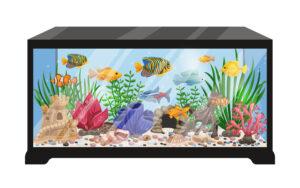 Maintaining an aquarium can feel like a full-time job, but let me assure you: it’s worth every drop of sweat! As an aquarium enthusiast, I’ve spent countless hours with my fishy friends, and I’ve learned the hard way that a solid maintenance schedule is the backbone of a thriving aquatic ecosystem.
Maintaining an aquarium can feel like a full-time job, but let me assure you: it’s worth every drop of sweat! As an aquarium enthusiast, I’ve spent countless hours with my fishy friends, and I’ve learned the hard way that a solid maintenance schedule is the backbone of a thriving aquatic ecosystem.
Why a Maintenance Schedule Matters
Imagine this: you’ve just come home from a long day, and the last thing you want to do is remember what needs to be done for your tank. However, without a structured maintenance schedule, you might end up with water parameters that resemble a toxic waste dump. I once made this mistake – after neglecting my tank for a couple of weeks, my poor betta fish looked at me like, “Seriously? You call this a home?”
According to the a recent report, a well-maintained aquarium not only provides a better environment for your aquatic life but also makes your tank easier to manage in the long run. So, let’s get into the nitty-gritty of what to do and when!
Your Monthly Maintenance Checklist
1. Water Changes
Frequency: Every 2-4 weeks
Water changes are crucial. Not only do they help remove harmful toxins, but they also replenish essential minerals. When I started doing regular water changes, my fish’s colours became more vibrant, and they seemed to be living their best lives! I typically aim for a 10-20% water change every two weeks, but that can vary depending on the tank’s bioload.
2. Filter Maintenance
Frequency: Once a month
Your filter is the unsung hero of your aquarium. It keeps the water clean and your fish happy. However, it’s important not to overdo it – cleaning too aggressively can remove beneficial bacteria. I learned this the hard way when I once scrubbed my filter like I was preparing for a science experiment. Instead, I now just rinse the filter media in some old tank water to preserve those good bacteria. Recent research emphasizes this point: always use tank water to clean your filter media!
3. Test Water Parameters
Frequency: Once a month
Testing water parameters like pH, ammonia, nitrites, and nitrates is essential for keeping your aquatic ecosystem balanced. I usually do this right after a water change. If you’re using a liquid test kit (which I highly recommend over strips for accuracy), you’ll get a better idea of how your tank is doing. A quick tip: keep a log of your test results. It’s helpful to see trends over time, like when my nitrates started creeping up—cue the “Panic Mode Activated” meme!
Your Weekly Maintenance Checklist
1. Visual Inspection
Frequency: Weekly
Just like I occasionally check my fridge for expired food (no, I’m not proud of it), a quick visual inspection of your tank is necessary. Look for signs of algae growth, dead plants, or any fish that seem out of sorts. I’ve found that a simple glance can save a lot of heartache later on. If something looks off, you can take action before it becomes a major problem.
2. Feed Your Fish
Frequency: Daily
Feeding schedules can vary based on the species, but I’ve found that consistency is key. I typically feed my fish a mixture of flakes and frozen food, but I only give them what they can eat in a few minutes. Overfeeding can lead to all sorts of issues. Plus, nothing’s sadder than a fish looking at you with its big eyes while you’re standing there with the food—except maybe a fish that just ate too much and is now swimming like it’s in slow motion.
Your Daily Maintenance Checklist
1. Top Off the Water
Frequency: Daily
Due to evaporation, you may need to top off the tank with fresh water. This helps maintain water levels and ensures your fish aren’t swimming in a kiddie pool! I always keep a jug of RO/DI water handy for this purpose. It’s a simple task that can go a long way in maintaining stable water parameters.
2. Enjoy Your Tank
Frequency: Daily
Yes, enjoying your tank is a critical part of maintenance! Take a moment to sit back and watch your aquatic community thrive. Observe their behaviour, and take note of any changes. This not only helps you bond with your fish but also allows you to catch potential problems early. The best part? It’s stress relief wrapped in a little fishy wonderland!
Conclusion
A well-maintained aquarium doesn’t just look good—it creates a thriving environment for your aquatic friends. Following a structured maintenance schedule can save you from some serious headaches down the line. Plus, it gives you the satisfaction of knowing you’re providing the best possible home for your fish.
Now that you’re equipped with a maintenance schedule, I encourage you to dive into the reviews of the products available on this website. They can help you select the right tools and supplies for your aquarium journey!
FREE Pet Guides for all pet owners
Get to know the basics about your pet
CLICK HERE to get your FREE Guide today!







